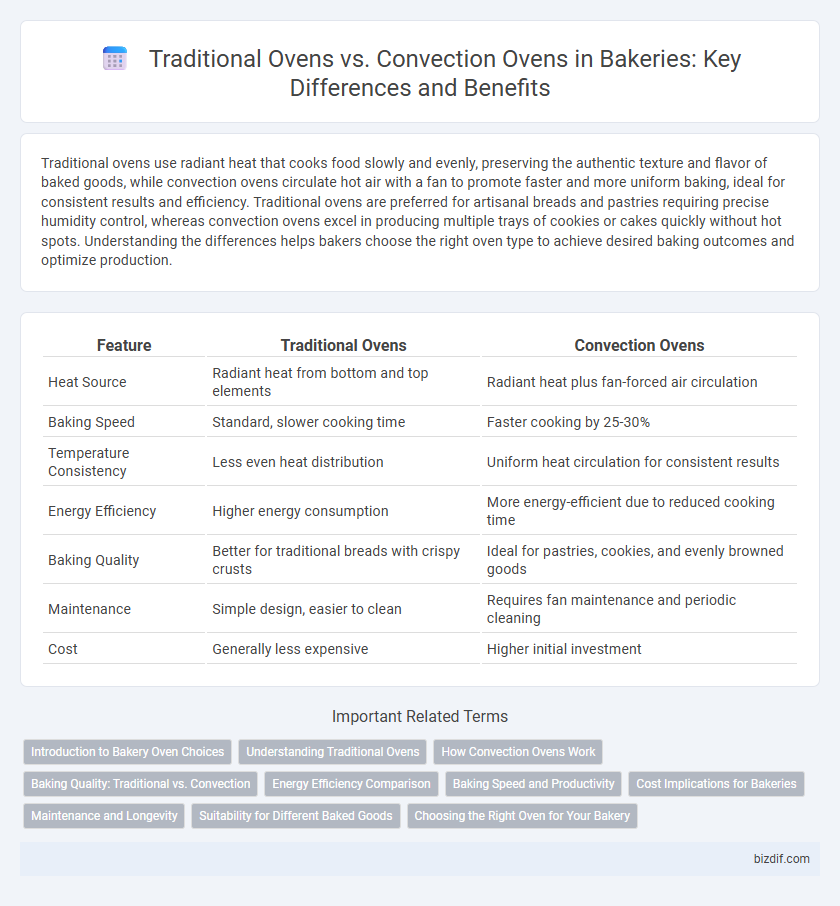Traditional ovens use radiant heat that cooks food slowly and evenly, preserving the authentic texture and flavor of baked goods, while convection ovens circulate hot air with a fan to promote faster and more uniform baking, ideal for consistent results and efficiency. Traditional ovens are preferred for artisanal breads and pastries requiring precise humidity control, whereas convection ovens excel in producing multiple trays of cookies or cakes quickly without hot spots. Understanding the differences helps bakers choose the right oven type to achieve desired baking outcomes and optimize production.
Table of Comparison
| Feature | Traditional Ovens | Convection Ovens |
|---|---|---|
| Heat Source | Radiant heat from bottom and top elements | Radiant heat plus fan-forced air circulation |
| Baking Speed | Standard, slower cooking time | Faster cooking by 25-30% |
| Temperature Consistency | Less even heat distribution | Uniform heat circulation for consistent results |
| Energy Efficiency | Higher energy consumption | More energy-efficient due to reduced cooking time |
| Baking Quality | Better for traditional breads with crispy crusts | Ideal for pastries, cookies, and evenly browned goods |
| Maintenance | Simple design, easier to clean | Requires fan maintenance and periodic cleaning |
| Cost | Generally less expensive | Higher initial investment |
Introduction to Bakery Oven Choices
Traditional ovens use radiant heat, creating a consistent baking environment ideal for artisanal bread with crisp crusts, while convection ovens circulate hot air using fans, ensuring even heat distribution for faster baking and uniform browning. Bakery professionals choose between these ovens based on desired texture, baking speed, and product type, with traditional ovens favored for classic recipes and convection ovens preferred for volume and efficiency. Understanding the strengths of each oven type is crucial for optimizing bakery production and achieving specific quality outcomes in baked goods.
Understanding Traditional Ovens
Traditional ovens rely on radiant heat from heating elements or gas flames, creating a slower and more uneven heat distribution ideal for baking artisanal bread with thick crusts. Their consistent, dry heat allows dough to develop rich flavors and textures without the rapid moisture loss seen in convection ovens. Understanding the heat dynamics of traditional ovens helps bakers perfect recipes requiring gradual fermentation and crust formation.
How Convection Ovens Work
Convection ovens use a fan and exhaust system to circulate hot air evenly around the food, promoting faster and more uniform baking compared to traditional ovens. This continuous airflow reduces hot spots and enhances heat transfer to the surface of baked goods, resulting in consistent browning and improved texture. Bakers benefit from precise temperature control and energy efficiency, which improves baking outcomes for breads, pastries, and other bakery products.
Baking Quality: Traditional vs. Convection
Traditional ovens provide even, radiant heat that enhances the texture and deep flavor of baked goods, ideal for artisanal breads and pastries requiring slower, consistent baking. Convection ovens use fans to circulate hot air, resulting in faster, more uniform cooking and a crisper exterior, beneficial for cookies and delicate pastries that require precise temperature control. Understanding the impact of heat distribution and airflow in these ovens is crucial for achieving desired crumb structure, crust quality, and overall baking performance.
Energy Efficiency Comparison
Traditional ovens typically consume more energy due to longer preheating times and uneven heat distribution, causing extended baking cycles. Convection ovens use fans to circulate hot air evenly, reducing cooking time and lowering energy consumption by up to 20-30%. Energy efficiency in bakery operations can be significantly improved by adopting convection ovens, leading to lower utility costs and reduced environmental impact.
Baking Speed and Productivity
Traditional ovens use radiant heat, resulting in longer baking times and uneven heat distribution, which can limit productivity in a bakery setting. Convection ovens utilize fans to circulate hot air, significantly speeding up baking processes and ensuring consistent results across multiple trays. This increased airflow enhances heat transfer, allowing bakers to produce larger batches more efficiently and reduce overall energy consumption.
Cost Implications for Bakeries
Traditional ovens generally have lower upfront costs but incur higher long-term expenses due to less efficient heat distribution and longer baking times, increasing energy consumption. Convection ovens, though more expensive initially, offer greater energy efficiency with even heat circulation, reducing baking time and operational costs. For bakeries, investing in convection ovens can lead to significant savings on utility bills and improved production throughput, offsetting the higher initial investment.
Maintenance and Longevity
Traditional ovens often require more frequent maintenance due to their simpler mechanical components that are prone to wear and uneven heat distribution, impacting long-term durability. Convection ovens, equipped with fans and advanced temperature controls, generally offer improved energy efficiency and more consistent baking results, reducing stress on internal parts and extending their operational lifespan. Regular cleaning and timely servicing of heating elements and fan systems are crucial for maximizing the longevity of both oven types in bakery settings.
Suitability for Different Baked Goods
Traditional ovens provide even, radiant heat ideal for slow-baking bread and pastries that develop a thick, crispy crust. Convection ovens use fans to circulate hot air, resulting in faster, more uniform cooking, which suits cookies and roasted items requiring consistent browning. Choosing between the two depends on desired texture and baking time, with traditional ovens favoring artisanal bread and convection ovens optimizing batch baking efficiency.
Choosing the Right Oven for Your Bakery
Traditional ovens provide even heat distribution essential for classic bread and pastry textures, while convection ovens offer faster baking times and consistent temperature control ideal for high-volume production. Selecting the right oven depends on your bakery's product range, production scale, and desired baking speed, balancing authenticity with efficiency. Investing in ovens with precise temperature regulation and durable construction enhances product quality and operational reliability.
Traditional ovens vs Convection ovens Infographic

 bizdif.com
bizdif.com